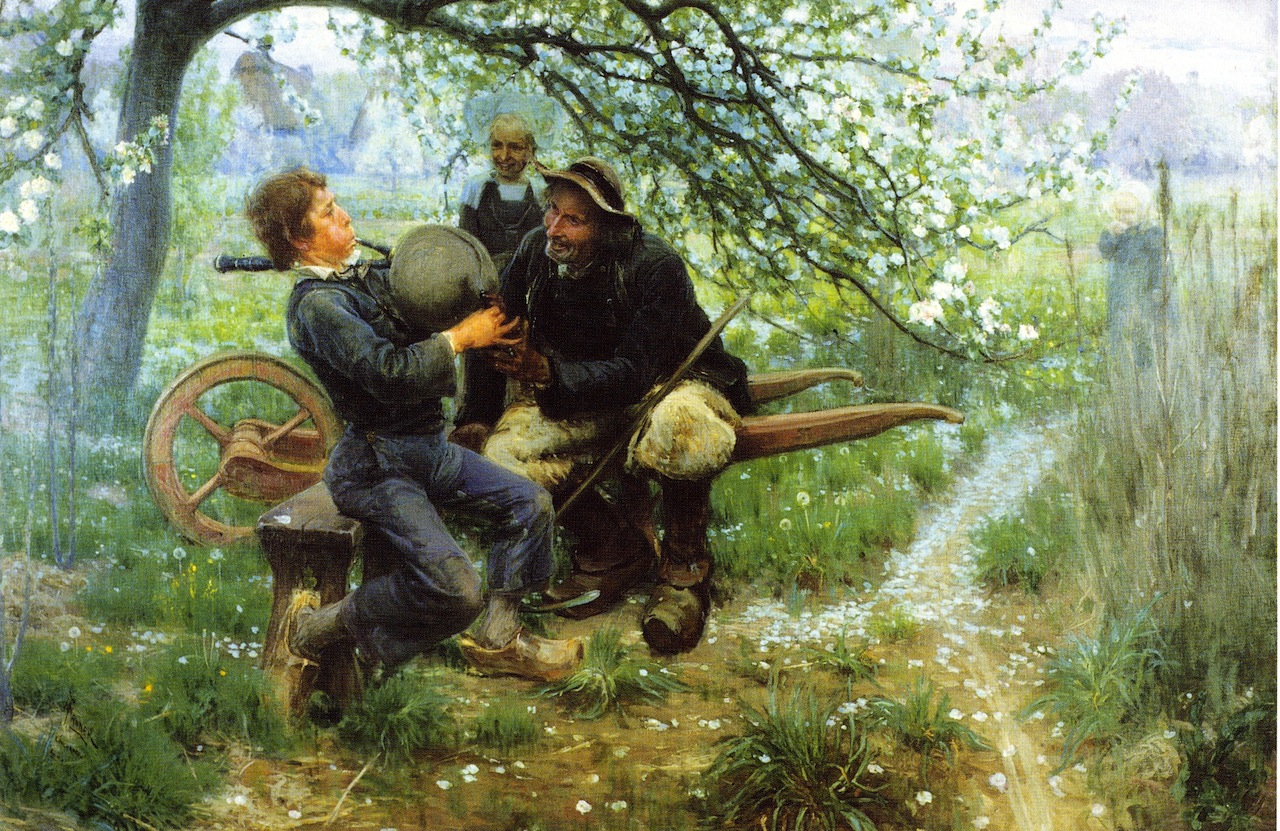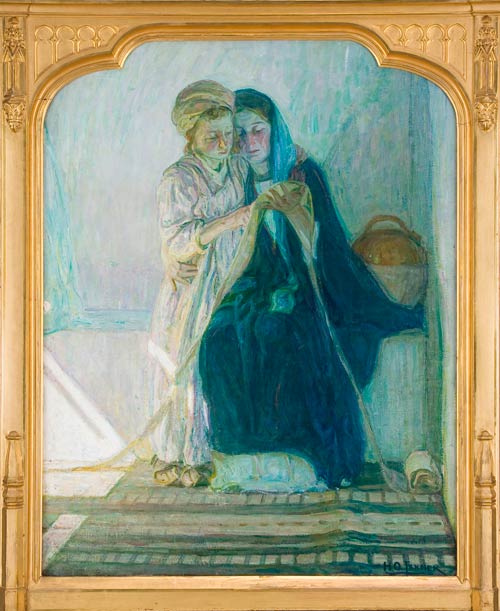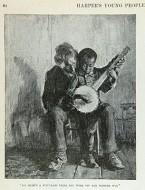Teach close reading skills, metaphors, and how to paint a philosophy of education with Henry Ossawa Tanner’s The Banjo Lesson
 The Banjo Lesson is part of the Hampton University collection. See there website for more details. Click on the painting for a high quality image that can be magnified.
The Banjo Lesson is part of the Hampton University collection. See there website for more details. Click on the painting for a high quality image that can be magnified.
As the moon sent a white beam through the little square window of Uncle Tim’s Cabin, forming a long panel of light upon his smoke-stained wall, it brought into clear view an old banjo hanging upon a rusty nail. Nothing else in the small room was clearly visible. Although it was Christmas eve, there was no fire upon the broad hearth, and from the open door came the odor of honeysuckles and of violets. Winter is often in Louisiana only a name given to the months coming between autumn and spring by courtesy, out of respect to the calendar; and so it was this year.
Sitting in the open doorway, his outline lost in the deep shadows of the vine, was old Uncle Tim, while upon the floor at his side lay little Tim, his grandson. The boy lay so still that in the dim half-light he seemed a part of the floor furnishings, which were, in fact, an old cot, two crippled stools, a saddle, and odds and ends of broken harness, and bits of rope.
Neither the old man nor the boy had spoken for a long time, and while they gazed intently at the old banjo hanging in the panel of light, the thoughts of both were tinged with sadness. The grandfather was nearly seventy years old, and little Tim was but ten; but they were great chums. The little boy’s father had died while he was too young to remember, leaving little Tim to a stepmother, who brought him to his grandfather’s home, where he had been ever since, and although the attachment quickly formed between the two had grown and strengthened with the years.…
…And so we see that the two Tims, as they were often called, had no great anxieties as to their living, although they were very poor.
The only thing in the world that the old man held as a personal possession was his old banjo. It was the one thing the little boy counted on as a precious future property, and often, at all hours of the day or evening, old Tim could be seen sitting before the cabin, his arms around the boy, who stood between his knees, while, with eyes closed, he ran his withered fingers over the strings, picking out the tunes that best recalled the stories of olden days that he loved to tell into the little fellow’s ear. And sometimes, holding the banjo steady, he would invite little Tim to try his tiny hands at picking the strings.…
An excerpt from Ruth McEnery Stuart’s short story “Uncle Tim’s Compromise on Christmas.” (Harper’s Young People, Volume 15, page 82, 1893) The illustration Tanner created to accompany this story inspired his painting The Banjo Lesson later that same year.
Look at The Banjo Lesson. Before reading the excerpts above, tell students the title of the piece and ask what is going on in this picture? This painting explores themes and images that may be familiar to students. See how much they can decipher through a group discussion. Encourage students to identify the evidence that supports their reasoning. Students should likewise be encouraged to share wonderings and voice confusions. As the conversation slows, explain you are going to read an excerpt from a short story that the Tanner illustrated, and that this illustration inspired The Banjo Lesson. After reading the excerpt ask how does this new insight change your understanding of the painting? What additional things do you see now?
Begin with art history
Born on the eve of the American Civil War (1859), Henry Ossawa Tanner was raised in Philadelphia, the oldest child in a large activist family. His mother had escaped slavery through the Underground Railroad. His father was a bishop and thought leader in the African Methodist Episcopal (AME) Church, a denomination renowned for advancing self-determination and black pride through a commitment to education and spiritual expression.
While sharing his father’s activist inclinations and deep spirituality, Tanner knew early on that he wanted to pursue his own path as an artist. He enrolled in the Pennsylvania Academy for the Fine Arts and quickly caught the attention of Thomas Eakins who played a pivotal role in guiding his career. In an attempt to get away from the racism that hindered his career and gain artistic acceptance, Tanner left America for France in 1891. Except for occasional trips home, he spent the rest of his life there, devoting himself to painting biblical scenes of intense spirituality. It was during one of these trips home that he created his most famous painting, The Banjo Lesson.
The Banjo Lesson grew out of a commissioned illustration Tanner created to support a short story in Harper’s Young People (see excerpt above and illustration below). Freed from illustrating someone else’s story, The Banjo Lesson allowed Tanner to share his unique perspective and showcase his artistic skills and genius. Challenging stereotypical norms that presented mocking images of blacks dancing with banjos, Tanner presents the banjo as a thoughtful art form, not a comical prop. Emphasizing the deliberate care and concentration required in training someone to master a musical instrument, The Banjo Lesson likewise refutes the stereotypical view of innate Black musicality. With a quiet dignity and respect for talent and tradition, this seemingly simple painting of a banjo lesson makes a radical break from prevailing racist imagery and reclaims the banjo as a symbol of cultural pride.
Look like an art critic
The Banjo Lesson is part of the Hampton University collection. See this image for more detail.
Brushstrokes
Point out and discuss: Throughout his career Tanner experimented with different painting styles that incorporated a variety of brushstrokes. Some of his paintings adopted the loose energetic brushstrokes characteristic of Impressionism. Other paintings used the careful, disciplined brushstrokes commonly used by realist painters. Tanner sometimes combined these different brushstrokes with great effect. What kind of different brushstrokes do you see in The Banjo Lesson? How do the brushstrokes in The Banjo Lesson serve Tanner’s intentions?
Turn, Talk, and Report Back (Possible answers: Broad painterly brushstrokes make the back wall shimmer like firelight and cause the hangings, shadows, and cloth-covered table to dissolve together. The floorboards likewise are rendered with broad, energetic brushstrokes that read like the grain of the wood. Like the items on the back wall, the coil of rope, the firewood, and the skillet are ill defined and blend with their surroundings. The fireplace hearth is likewise rendered with swirls and smears that read like a rough stone surface illuminated by firelight. In contrast, the grandfather, the child, and the banjo are rendered with meticulous, disciplined brushstrokes that draw out the smallest details. The facial features and hands are sensitively rendered with delicate brushstrokes that depict individual expressions and gestures. These detailed figures against the indistinct background draw the viewer to look more carefully at the interaction of the two figures. The juxtaposition of detailed figures against an abstracted backdrop heightens the complexity and individuality of the individuals.
Light


Point out and discuss: Tanner frequently used light to express the spiritual essence and heighten the drama of religious moments in his biblical paintings. In The Annunciation (1898), Tanner depicts the angel Gabriel as a shaft of brilliant white light that illuminates an innocent and uncertain Mary as she learns she is to become the mother of Jesus. In Daniel in the Lions’ Den (1896) Tanner uses somber blue moonlight from an overhead window to highlight Daniel’s bound hands and calm repose to accentuate his serene spirituality and quiet resolve as he faces his unjust imprisonment. How does Tanner render light in The Banjo Lesson? How does this treatment accentuate the painting’s story?
Turn, Talk, and Report Back (Possible answers: There are two sources of light that converge on the figures. From the left, the natural light from a window or doorway casts a white, blue glow over the figures and back wall. This light source frames the two figures in a square of light surrounded by darker shadows. On the right, the fireplace casts a warmer yellow light over the two. The way the light converges on the two accentuates their individuality. The light from the fireplace brings out the warm brown tones of the boy, while the light from the window bathes the grandfather in cooler, darker tones. The convergence of light sources on the back wall creates a halo effect around the two figures further accentuating their solemnity and communion. To further underscore this holy communion, Tanner concentrates the light on a pitcher and bread on the golden-lit table, meaningful symbols of ritual, sharing, and cultural transmission.)
Reading Metaphors
Point out and discuss: Compare Tanner’s The Banjo Lesson with the original illustration he created for Stuart’s short story. Note the items he has added. With such a spare composition these additions seem especially significant from a compositional and meaning making perspective. Note the two vessels in the lower right corner. Tanner counter balances these with a dark coat hanging in the upper left corner. This creates a strong diagonal across the composition that aligns the figures with the vessels. What is the significance behind these vessels and how do they serve Tanner’s intentions?
Turn, Talk, and Report Back (Possible answers: The two vessels are nestled against each other like the grandfather and the child are positioned. The colors of the vessels likewise mirror the figures. The earthen jar has the same warm brown tones as the boy, while the metal container has the same cooler dark tones as the grandfather. These parallels underscore the relationship between the two figures and reinforce Tanner’s underlying message on education. The earthen jar is an open vessel waiting to be filled. The metal container has been steeled by the heat and is valued for its ability to dispense its contents. These vessels have a noble purpose and practicality. And while each vessel is unique, they compliment and enhance the other.)
Think like an artist
Tanner built up the levels of meaning in The Banjo Lesson by adding metaphorical symbols such as the two vessels in the lower right corner. Use common everyday objects as metaphorical symbols to reenvision a favorite picture of you with your family or friends. Consider how best to draw out the characteristics that your objects share with the people in your photograph. Photograph this arrangement and display the original photograph and the assembled photograph together. Does your original photograph take on added meaning?
Life Lesson



Accept everyday’s offer to be a student and a teacher. Tanner was raised with a deep appreciation for education. His parents were both extremely well educated and well written. Throughout his career, he was mentored by master artists such as Thomas Eakins and Jean-Paul Laurens. Tanner in turn mentored aspiring artists, most notably Robert Henri, an originator of the Ashcan School. Tanner’s The Bagpipe Lesson (1893), The Banjo Lesson (1893), and Christ Learning to Read (1914) express a refined philosophy of education that was ahead of its time (and may be ahead of ours).
These paintings celebrate informal, nurturing modes of education where the teacher and student are equally engaged in a transmission of empowering cultural knowledge. Tanner captures the mutual respect, trust, connection, and patience involved in the student-teacher relationship. Note how the bagpipe, banjo, and even the unfurling scroll, physically dominate the young learner. But, also note how the steady support of the teachers, reassuring and calm, suggests these tools of knowledge and expression can be mastered. The student struggles, the teacher guides, together they learn and grow. When teaching responsibilities overwhelm, take a deep breath and let these master educators remind you why you became a teacher.
(Reading/Language Arts teachers take note: Christ Learning to Read is an interesting painting on multiple levels. For one, what do you give a guy that has everything—or at least a guy who is the son of God? Tanner’s answer: reading lessons.)
Related Video
- Conversation: Henry Ossawa Tanner, PBS News Hour. (8:34) Curator Hannah Marley provides an overview of Tanner’s career and work.
Integrating into Your Curriculum
Artists oftentimes use common visual strategies or signposts to alert viewers to significant details in their art. Here are some ideas for using these visual signposts to unpack a work of art. Remember, the close reading skills in art appreciation are similar to the close reading practices taught in reading.
Literature Links: What piece of literature would you partner with The Banjo Lesson? This painting could inform the study of slave narratives and the antebellum south such as:
- Ruth McEnery Stuart’s “Uncle Tim’s Compromise on Christmas,” the short story that informed the composition and characters in this painting. (Note: The portrayal of the characters in this story could be considered stereotypical and the view of slavery sanitized. For a more authentic and accurate perspective, you may want to supplement it with some of the slave narratives listed below.)
- Mark Twain’s Adventure’s of Huckleberry Finn
- Harriet Beecher Stowe’s Uncle Tom’s Cabin
- Harriet Ann Jacob’s Incidents in the Life of a Slave Girl
- Frederick Douglass’ Narrative of the Life of Frederick Douglass, an American Slave
- This site is rich with excerpts from slaves narratives. Consider in particular those readings under “Conditions of Life.”
Writing Opportunity: Historical fiction, character development, and dialogue
Build on the setting and characters Stuart created in the excerpt above and that Tanner depicts in his painting, have students continue the story with further character development and bring the scene to life with dialogue between the boy and his grandfather. Through their added character development and invented dialogue, have students explain why the grandfather and the boy’s thoughts were both “tinged with sadness,” why the banjo was considered “a precious future property,” and what were some of the stories the grandfather would “tell into the little fellow’s ear.” Compare the students’ new endings with the original. Which do the students like best and why?
How would you use this painting to elaborate on one of your units of study? Please share if you have other ideas on how to teach The Banjo Lesson by Henry Ossawa Tanner as an English/language arts lesson plan.


Comments are closed, but trackbacks and pingbacks are open.